#scarecrow analysis
Explore tagged Tumblr posts
Text
Writing Scarecrow as a heartless monster doesn't make sense to me, I know and respect those who do this in the fandom, but it's just not for me.
And I say that because there's multiple times in the canon where he shows himself to still be human under the mask. I'm not saying he's a good person, far from it actually. BUT that doesn't mean he CAN'T DO GOOD for christs sake.
He tortured his favorite students abuser, in which it's heavily hinted to be sexual abuse
He returned to teaching multiple times, even teaching classes IN arkham
He gave up a scheme to make Gotham illiterate all because Robin convinced him that knowledge is important and that HE is important
The little girl he abused in Cycle of Violence drew him a picture and he actually cried over it, and in the end he saved her from an exploding building when he very well could have left her to die.
To me, this is enough proof that he does have a conscious, even if it is small and useless most of the time. When push comes to shove, he CAN do the right thing
Batman villains are meant to be complex humans, confused and mentally ill humans who just need help. BTAS taught us all that as kids, so why did we become cynical adults who can't have a little fun? Let him be human, make mistakes, occasionally do good, and just...exist as a flawed character.
#Jonathan Crane#Scarecrow#The Scarecrow#Batman#BTAS#Study Hall#DC#DC Comics#Batman Rogues#Scarecrow Analysis
304 notes
·
View notes
Text
More before and after!! At this point I'm just rambling, I apologize! :""D I'm just so fascinated with it, like....
It's interesting to see how Crane's statement in the first version is delivered with this tone of intellectual detachment, almost diagnostic. His voice is kinda unbothered, reflecting a position of authority and understanding rooted in theory rather than personal experience.
While in the second version, the same statement is transformed by his lived experience. His rough voice and bitter tone indicating a man who has not only encountered but been consumed by the very fears he once clinically described. The words now carry a visceral, personal weight; they are no longer an observation but a confession, a weapon, and a warning. His tone suggests anger, pain, and maybe even a sense of betrayal - he has become what he once analyzed, and the words are now etched in his soul, not just his mind.
It's academic knowledge vs cruel personal experience.
God, I love how much weight this iconic sentence now carries thanks to Arkham Shadow! ;/////;
#mini character analysis#just some late night thoughts really#for funsies#Jonathan Crane#Scarecrow#Arkham Shadow#Arkham Knight#DC comics#Batman
149 notes
·
View notes
Text
Scarecrow stays being a menace to Jason
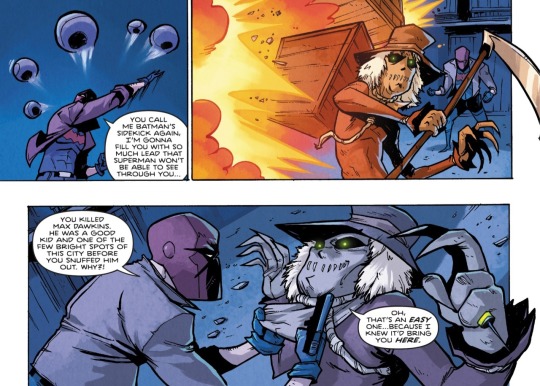
Truth & Justice

Gotham War: Red Hood

Robin Lives (elseworld)
#dc comics#dc#comics#comic books#comic pages#comic panels#truth & justice#haunted by the past#gotham war#the gotham war#gotham war red hood#death in the family#robin lives#batfam#batkids#jason todd#red hood#rogues gallery#batman rogues#jonathan crane#scarecrow#character dynamics#funny#angst#media analysis#comic analysis#character analysis
157 notes
·
View notes
Text
Understanding Arkhamverse scarecrow.
I’ve been wanting to make this post for awhile. I think with the release of Arkham shadow we might finally have all the necessary pieces to understand the life of Jonathan crane, his motivations and his descent into obsession.
This scene gives us a lot to work with.
Let’s start with this. It seems like unlike some versions of crane who see fear as a tool. The true face of control and power. Arkhamverse Crane sees fear as everything. This has been observed all throughout the series. From him discussing how fear drives every human action in Arkham asylum to this line in Arkham knight just before he’s defeated.

Something else I noted in that clip was Jonathan immediately trying to rationalise and analyse his reaction to his toxin using fear.
Now we’re not quite sure what this original chemical of his does. Only that its intention is to trigger the shadow within people. We can assume through both his and Batman’s reactions that it aims to do this through a similar process to the future fear toxin. Bringing out and facing people with their deepest fears. Hoping they may become them.
Though that leaves the same question. Why jump to fear. He’s clearly talented in chemistry. Surly there would be more direct ways to bring out people’s demons rather than only focusing on a single part of the shadow. Well I believe that shows us even before this realisation Jonathan had some experience and issues with fear. It’s also why his greatest fear seemingly is just. Fear itself. The helpless fears given to us from evolutions and experiences long before our time. Inherent fears.
However we also shouldn’t disregard his fixation on the shadow itself. Why does he seemingly want to get people to become their worst selves. As seen in his tapes with Harvey. Why is Jonathan crane like this?
Well I think there may have been a time where he saw someone consumed by fear. Destoryed by it.
This could draw an interesting parallel to the story of Amadeus Arkham whose story started when he watched his own mother be consumed by her mental illness before ending up consumed by it himself. I think this parallel could make a lot of sense given that I’d argue although the joker plays a more personal threat scarecrow is the main villain of the Arkham series.
So allow me to tell you what I believe to be the story of Jonathan Crane in the Arkham series. Assuming that the brief backstory we got in his Arkham asylum character bio isn’t considered canon.
A parent or other caregiver suffered from great anxiety and paranoia that caused them to do great harm. Maybe overtime perhaps in one tragic incident. Jonathan internalised this and began to grow interested in the mind. Maybe it started with good intentions. After all he does claim to be helping people in Arkham shadow. Maybe that was a lie and he’s been twisted for a very long time. Who knows.
He began work at Gotham state university and we know how that ended up.
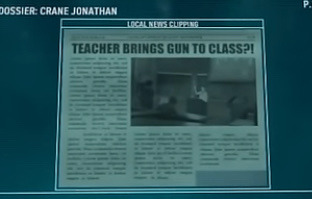
Though it’s worth noting he clearly was brilliant. So much so that this incident unlike most versions of the character did not get him fired because his classes brought the university so much revenue. Instead he left on his own accord to take over as head of rehabilitation at blackgate. An odd choice given the amount of institutions bidding over him. They were likely offering more, far more than the job he took. Though I think his motivations for this were split. Partly is of course the obvious motivation of easy access to test subjects that couldn’t easily speak out. We can see in the previous game that he was running controlled tests likely of the chemicals we see used in Arkham shadow and his subjects were willing participants.
Now either not enough people were choosing to participate or the effects were becoming so potent it risked drawing unwanted attention to his work.
The second reason connects to my proposed backstory. Maybe he was curious to explore how fear connects and causes crime and violence via the shadow. The chain reaction that begins WITH fear.
We then see the events that happen in Arkham shadow and we find out alongside Jonathan that he’s been inhaling his own chemicals during testing. Smart move there buddy. This sends him into a psychotic spiral and forces him to confront and become his greatest fear. His shadow. Fear itself. We can see that this truly set in given how messed up he looks the following day. Not to mention his actions becoming erratic. No longer thinking to hide his crimes until after he severely injures Harvey and huffing his own chemicals right in court.

Afterwards? We’re not sure. Of course he goes on to become the scarecrow then the events play out as we see throughout the rest of the Arkham games. He gets mauled by killer croc during the events of asylum and his previously smug and joyfully sadistic personality get destroyed alongside his face. The experience clearly changed him quite drastically as a person. Although clearly it didn’t shake his core ideals and beliefs about the all consuming nature of fear.
How pitifully ironic that this idea became true in the end. As he’s injected with his own toxins his mind collapsing and giving way to permanent insanity and terror. Fear really was everything Jonathan had left in the end.
#batman#jonathan crane#dc rogues#arkhamverse#arkham shadow#batman arkham knight#batman arkham series#arkham scarecrow#arkham asylum#batman arkham shadow#batman arkham asylum#batman arkham origins#av!scarecrow#ak!scarecrow#scarecrow#the scarecrow#batman scarecrow#scarecrow batman#asylum scarecrow#Arkham shadow Jonathan Crane#theory#character analysis
84 notes
·
View notes
Text
slight character analysis, at least how I see Jonathan Crane / The Scarecrow
scarecrow is impatient and impulsive, unlike most villains he doesn't do crime for fame or money, he finds his work genuinely fascinating and completing.
his main motivation is the euphoria it brings, he's a freak and craves it. without that feeling he feels empty, which isn't a bad thing but it's boring. and makes him more irritable.
he won't threaten to hurt your family or loved ones, that's too much work and he doesn't care about them. he wants you to be scared, and if you're one of those people who "aren't afraid to die" he gets irritated.
sure you might not be afraid to die but you don't really wanna get hurt, you don't want to be slowly, continuously in agonizing pain and fear while someone laughs at you, do you?
very easily ticked off if you don't respond the way he wants, not scared immediately? no phobias to use as an advantage? fine, blades and needles. that didn't work? well, you certainly weren't going to make it out alive in the first place.
#📼 : rambles#📎﹕dc#can you tell I like BTAA#dc#dc comics#jonathan crane#dc scarecrow#the scarecrow#scarecrow#batman rogues#gotham rogues#character analysis#technically this is more specific scarecrows...so ill tag those#btas#btas scarecrow#btas jonathan crane#btaa#btaa scarecrow#btaa jonathan crane#ALSO#the dark knight#batman the dark knight#batman the animated series#batman the audio adventures#is it called the dark knight i forget#pretty boy bale crane is what i mean#you guys get it
59 notes
·
View notes
Text
How good is BTAA Scarecrow at therapy really? (An analysis) (Part 1)

So I naively thought that this'd be a laugh. Take the unethical psychiatrist, analyse his techniques, highlight what he's doing in real world contexts and give him a rating. After hours of working on this though I unintentionally managed to construct a theory on how BTAA Jon might approach therapy. Oop.
This part contains- a breakdown of some psychological approaches in therapy settings, character analysis/theory of Jon (in the conclusion), Jon being awful
Disclaimer- I am not a trained psychologist or therapist or anything of the like. I did study the topic under a teacher who was a trained psychologist though, and I still very much like psychology, so that basically makes me an expert in this field. This is a joke. Do not take my word as gospel. This post was written for fun and will probably have a mistake somewhere.
Harvey and Two-face will be referred to seperately in this analysis, but if referring to both Harvey will be used as default. Jonathan is Jonathan.
A-Level psychology don't fail me now 🙏
Session one/"two"-
The following all takes place in S2, Episode 5
The first section of our analysis takes place on March 4th and the time is 2:02pm, surprising no one as Two-Face is present. Jonathan begins the session by setting up a recording and going through standard legal procedure, following the “Code of Medical Ethics” (0:15) of Gotham. He also makes note that the first tape was destroyed, again probably for legal reasons. Good start.
Being that it was Harvey that destroyed the last tape machine due to a mishap of it not being the first session and Harvey refusing to perceive the number one, Jon asks him to elaborate- “tell me more about that” (0:56). Asking for more info on something a client has said often shows interest, which helps with relationship building, and on the mental health professional’s end would help build an understanding of the client. It has been established at this point that the session is for “introductory psychoanalytic examinations” (0:24), so that latter point is especially important. Killing two birds with one stone, very efficient. Whether Jon actually shows interest towards Harvey’s fascination for the number two though is a completely different matter.
In addition, throughout all this Jon also gives terse responses, “I see.” (00:49) (1:11), to Harvey’s statements to indicate he’s listening and doesn’t try to weigh in. One-sided conversation such as these allow the client to speak as much as they need to, the sessions are for them after all.
So overall, Jonathan is being very professional so far.
At 1:21 of the episode is when Jon finally decides to give his thoughts (after Harvey has finished talking) stating that "The best way for [him] to help [Harvey] is to establish a bond of trust between [them]” (1:26), something that Harvey agrees to. Truthfully, another thing that is important between client and mental health professional, so his approach isn’t wrong.
Upon Harvey agreeing to this, Jon promptly demands that he be given the coin, something Harvey doesn't want to do. At being told that he isn’t comfortable with that, Jon points out that "it's not up to [Harvey]" (1:46) and takes the coin anyway through it's infallible decision-making prowess and the full knowledge that Harvey relies on the coin for all his decision making. He successfully gets the coin, Harvey is unhappy, and trust is established. But not really because Jonathan didn’t respect Harvey’s personal feelings nor wishes. Which is a breach of ethics. Horrible decision really. Jon places the coin on the table, presumably in a place where both he and Harvey can see it, and he declares aloud that it's on the table. In any other context this might have actually been a good way to maintain trust while seperating an item of emotional importance from a client, but such actions should only be taken with the consent of said client. 🚨 JONATHAN IS BEING UNETHICAL HERE. 🚨
Afterwards Jonathan reopens the session, “We meet again for the very first time” (2:06) as though everything said and done previously never happened. He goes on to ask the pair to reintroduce themselves. He notably sounds more casual here and upon hearing that Two-Face is older asks “Harvey was here first, wasn’t he?” (2:21) in a tone that doesn’t sound genuinely surprised. The question was most likely asked as a method to fish for confirmation or another elaboration.
He then moves on after Two-Face is done speaking, very obviously not caring about the reasoning given for Two-Face's origins, to say that he heard “a horror story” (2:58) referring to the courtroom incident. Despite Two-Face's response being a positive one, claiming “That day set me free, like it was in the beginning” (3:11), Jon instead believes that the incident “found [Two-Face] in [his] hiding place” (3:17) and that he was hiding because he was, and still is, “afraid of what [he] would do without Harvey” (3:27). Jon weighing in should have ideally been avoided here. Therapy is normally approached with a mentality akin to teaching a man to fish, where the point is to teach a client how to identify and analyse their own feelings.
Instead of stating why a client thinks/feels as they do, a mental health professional will tactically ask questions in an effort to get a client to reflect. Jon asks some of these questions- “Do you ever wonder what if that acid had taken more than half of your face that terrible day? [...] What if when the acid had done its business, there wasn’t enough of Harvey left to do the serious work?” (3:30) which, in a way, counts. There is still criticism to be had here though as wording can passively influence how a client thinks. Describing the day that Harvey went through his incident as being “terrible”? Probably made Harvey view a day considers favourably as something more negative. Likewise, stating that Harvey could have somehow been lost that day from the acid in all certainty no doubt might have instilled some sense of unease in Two-Face. You should avoid making clients uncomfortable. Bad therapy moment.❌And then Jon follows these questions to Harvey up with another explanation, "You won't let it [cross your mind] because it frightens you [...] the thought of being alone." (3:50).❌❌
“Let’s try something. Bear with me” (3:58) Jon says next, reaching for the acid he inexplicably keeps in his draw. Upon being asked what he’s going to be doing with it by one (two?) Two-Face, Jon retorts with his own question, “What are you afraid I’m going to do with it, hmm?” (4:18) before pissing around with the acid and wanting Harvey to “Tell [him] about the fear” (4:29). This is an example of Jonathan being unethical again. Remember gaining the consent of clients of a therapeutic activity you want to do together is of utmost importance. Likewise, then Jon clarifies that he thinks that Harvey is scared of the “other” (5:05) attribute he acquired that day that wasn’t just the acid damage. Believing that tapping into this fear would cause emotional distress, he proceeds to dunk Harvey’s coin into the acid, destroying it. 🚨JONATHAN IS BEING UNETHICAL AGAIN, DO NOT DELIBERATELY CAUSE MENTAL DISTRESS TO CLIENTS OR DESTROY THEIR PROPERTY. 🚨 According to Jonathan himself he considers his actions “aggressive intervention” (5:30), but Jonathan’s judgement for considering this necessary can be called into question.
Finally, after everything is said and done and Harvey has in fact been reduced to “a puddle of quivering terror” (5:10) like Jon predicted, Jon is again back to asking Harvey questions about his feelings and acting like a good mental health professional. He even reassures Harvey that he understands! Creating an environment of understanding and lack of judgement is important in any therapy setting. And, further playing his role as a psychiatrist, Jonathan in all his understanding of Harvey’s inability to make decisions anymore prescribes him with meds of his own creation. He explains what the medication does positively, in fluffy terms rather than anything technical, and gets Harvey to take it. While Jonathan is allowed to prescribe medication like this being a psychiatrist rather than just a psychologist, the fact that he starts tooting his own horn about how good the meds are, neglecting to talk about the potential side effects, and then makes Harvey take them anyway is, again, unethical. Informed consent should always be taken from clients before prescribing and a therapy session is an inappropriate setting to advertise your products.
In conclusion:
Jonathan takes more Ls in this session of therapy than he has moments doing his job in the proper way, and his approaches to psychological methods indicate that he takes those Ls not from any amount of ignorance on his part but from a blatant disregard for the well-being of his clients. He plays nice and uses correct therapy techniques consistently only up until he establishes a "bond of trust" by removing Harvey's coin, despite Harvey's feelings. After, Jon can be observed descending more and more into ignoring basic therapy practices; providing his own viewpoints on events, outright stating why Harvey feels as he does, refusing to explain what he's planning to do, eventually getting to the point where he's talking more than the clients during the session. All this happens until Jon permanently rids Harvey of the coin for good, leading to an emotional breakdown in the clients and a subsequent administration of drugs.
If I didn't know any better I'd say that during these events, Jonathan goes from setting up the session like any mental health professional would to gradually steering the session into the direction he wants it to go. Even moreso if one regards how he brings up the court room incident of his own volition completely unprompted (2:50) which then leads that into bringing up the topic of fears. Which eventually leads to dropping the coin into acid... Now this idea is insidious enough as it is, right? I'm sure this Dr Jonathan Crane is a well meaning psychiatrist, I mean he's following Gotham's Code of Medical Ethics! So here's also a slightly different perspective to all this:
Jon is speedrunning therapy.
I mean think about it- not even two minutes into the session and Jon basically forces Harvey into "trusting" him. This is only the second time that they've had a session together mind and trust is a thing that often takes months or even years to form between a mental health professional and a client. The chosen method of building trust was to remove a valued item from Harvey and one that he relies on, again something that takes multiple sessions to build up to and- as had been stated- is a valid trust building technique. After taking the coin Jon still leaves it in a place where Harvey knows where it is, just like you'd expect in a therapy setting. Jon even asks the pair to introduce themselves before deliberately steering things into talking about the court room incident which is the nexus point for why Harvey relies on the coin as far as he's concerned. Even him outright telling Two-Face what his fears are could be interpreted as him not wanting to spend months doing the standard therapy approaches that aren't even a guarantee for any progress.
In fact, Jon doesn't even attempt to destroy the coin either until the following happens in order: he tells Two-Face he thinks the court room incident found him and he was hiding out of fear of what he'd do without Harvey, he then asks Two-Face if he's ever thought about what he'd do if Harvey was unable to do much of anything anymore, then outright tells Two-Face he's afraid of being alone before then saying "Let's try something" (3:54) as though he's about to demonstrate his point, forcing Two-Face to acknowledge it.
"I think we had a breakthrough" (5:36) indeed. Breakthroughs are when a client successfully identifies something about themselves, like where a thought or feeling or bad habit stems from. A client having a breakthrough is the point where therapy can progress. And, hey, Harvey probably did make a breakthrough from losing his coin, though it was forced. This breakthrough led to being given a special drug. Which is something to be explored in a later part.
Of course though none of this really matters. Therapy is about treating a person as a person and "teaching a man to fish". Apparently Jonathan doesn't care about fishing.
FINAL SCORE FOR THE SESSION:
🎊 3/10 🎊
Jon is definitely not lacking in skills when it comes to psychology or therapy techniques, in fact he seemed decent enough for the first chunk before the session metaphorically drove off a cliff through his driving- intentionally no less. He simply lacks regard for the feelings of his clients and is a walking ethics breach. Likewise he took deliberate control of the session, and whether the end result was intentional or not this is definitely not something to do in a therapy setting. His approach to "therapy" may lead to breakthroughs, making his clients recognise the things he identifies, but it's not in the true spirit of therapy. It's doubtful that a client under him would ever learn the techniques they need to overcome whatever things they might struggle with.
...And this isn't even getting into how much enjoyment he seems to get from making his clients uncomfortable.
#Batman#Batman the Audio Adventures#BTAA#BTAA Scarecrow#Scarecrow#Jonathan Crane#text post#analysis#Character analysis#How good is Scarecrow at therapy really?
82 notes
·
View notes
Text
Analysis on YANDERE PLATONIC TAS villains. Pt2
Harley Quinn
Joker
Harley + Joker [Reluctant team-up, they want nothing to do with each other]
Killer Croc
Scarecrow
Penguin
TW: Use of the word 'Mommy', 'Daddy', and Dumb-ifying/Babying.
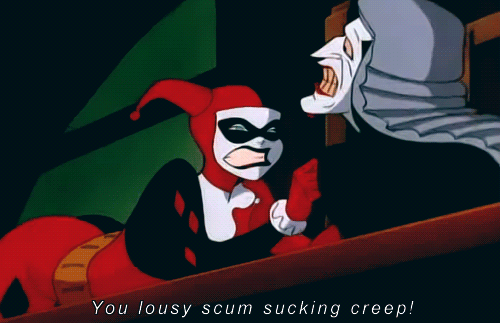
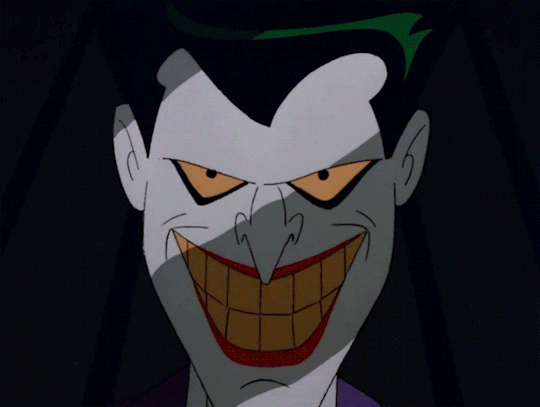
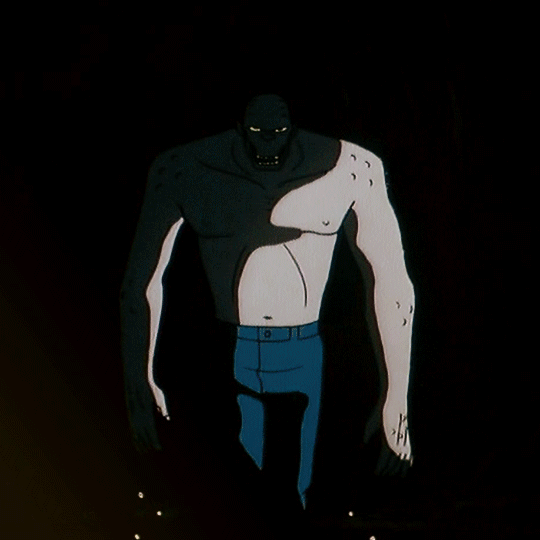
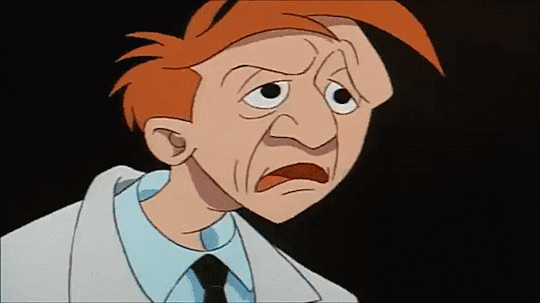
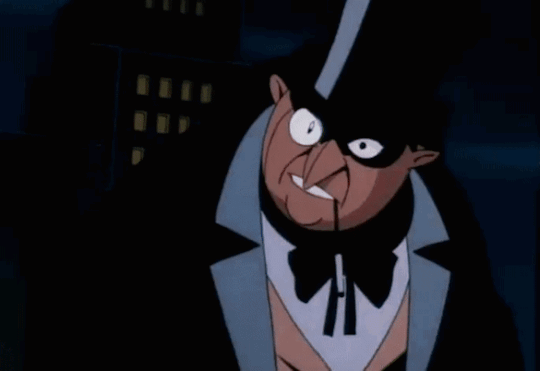
For the Yandere Archtypes: https://www.tumblr.com/helpfandom/724022554446135296/types-of-yandere?source=share Once, again, yandere_auxillary made it, I just can't find them for some reason.
I set apart Harley and Joker because they would be different depending on if they are together or not, hence why there are two versions of each. One alone, and one together.
Harley: See, her characteristics when alone would be, Impulsive, Delusional, Sadistic, and Clingy. Sadistic and Clingy are supposed as opposing forces, but it's actually not true. Her sadism comes from the fact that she doesn't mind see you get hurt trying to escape, {and even slightly enjoys it}. Her clinginess comes from never having this feeling before as a kid, or even towards a kid, and her being confused, even a little scared of this feeling. She doesn't try to find out more about you, she's delusional after all, she truly thinks that you're just like her. Her delusions are something that you will just have to deal with, as she completely believes that you love her too. To break her delusions would end with Reader being harmed physically, or to end up locked alone in a room, waiting for her to open up the door and let you back out. She's impulsive in that she is quick to kidnap, not even knowing your name at that point, but knows she wants to be your Momma. She doesn't stalk you, she's too impatient for that, but she keeps you in her mind. The next time she sees you, she attempts to kidnap you. She would fight Joker for you. She's not always going to be there for you to be considered her 'kid', nor will she truly take care of you fully. Not enough for a developing child. "Momma's here!~ Come here baby, Mommy got some new jewelry for her baby. Just let Mommy take care of you!"
Joker: Yikes. Good luck. Sadistic, Impulsive, Possessive, some of the worst traits to have. He would be fully willing to push you into acid like he fell into, if it meant having you stick around with him. He would not entertain the idea of you even having other parents. Not even Harley could attempt to take you away from him. He's always been shown to be impulsive, and possessive, with Episode 47, season 1, when Harley teams with Poison Ivy. Imagine that, but much much worse. He would refuse to let anyone get close to you. He would feel nothing but glee when you try to escape, only to be harmed by his hyena's. He found a kid {you} and decided to try to poison you against Batman, quickly kidnapping you and taking you home. Finding your uncaring attitude intriguing and hilarious. He will constantly take you places, only to kill or threaten the people who try to help you, and then take you back home where he tries to get you to help with a plan. He's gritting his teeth together, fed up with you refusing to help him. "Listen here kid. You're going to help me with my next thing, or your other-family says beddy bye."
Harley + Joker: Impulsive is the one thing that the two share from their alone counterparts. (Surprising, considering what they shared, but I'll explain.) Self-Indulgence, is the next characteristic that they have. Despite all that they share, they bounce off of each other with jealousy, causing their Sadism to in fact, go away, because they are busy trying to poison you against the other. Terms like: "Come here suga', Mommy's got you some brand new jewlery, did Daddy get you some jewlery? Well, it's not as shiny as Mommy's is it? or "Doll, did Mommy get you some cheap-o jewlery? Well, good thing that Daddy got some candy for you!" are commonplace and you half-way expect it to be quite honest. They often fight and make-up, before fighting the next day and making-up the next. Wash, Rinse, and Repeat. As much as they hate each other and the way that the other parent raises you, they hate the alternative to leaving, or making the other susceptible for Batman to take you away from their loving grasp. "But who do you really love, sweetie? Mommy, or Daddy? It better be me.
Killer Croc: He is Clingy, Obsessive, Overprotective, and Self-Indulgent. His fear of being inadequate and being seen as nothing but a monster, [which is why he does crimes. If you see me as a monster, maybe I am a monster. Maybe I'll show you what a monster looks like.] is why he is all of those traits. He fears that the one person who is indifferent to him / nice to him [Reader, or You,] would be eventually changed to fear him by Batman. Killer Croc would be the type to baby you, even dumb-ifying you if that makes sense. His fear of inadequacy makes him put restraints on you, even once we're past the escape phase, putting gloves on you, being Overprotective so much, because he wants to keep his little baby safe. He sees you as a 'baby' because of your indifference to him being a mutant of sorts, and sees that indifference as naivety. He craves your approval and needs you to need him to do everything for you, hence, his baby-ing. Just let him control your every action and love him for it, okay?
Scarecrow: He is Impulsive, Manipulative, Obsessive, and just a bit Sadistic. He's less likely to experiment on such a nice darling who knows that he was a professor or wants to learn more about what he taught, but punishment wise... He's not afraid to use fear gas. He doesn't want to use fear gas on you, more complacent to study his own psychology, and why he's obsessed with you, and he can't study that if the subject is missing his child... He's impulsively manipulative in the way that he's immediately jumping to a plan to manipulate Reader into coming into his grasp. He just wants to put you in a little container and watch everything you do, just to study you like a little pet. Just make sure you don't run away, m'kay?
Penguin: He is very Clingy, Overprotective, and Impulsive. He's been betrayed over and over again by people he thought he could trust, been kicked out of the society he tries and desperately wishes to join, so when he finds a darling who gives no shits, and cares not for what he is, so long as he is a good person? He impulsively falls into a platonic love, wishing to become the parent he wishes he could have, and what kind of parent would he be if he didn't protect his kiddo? He wouldn't let you out at all, fearing the upper-class or BATMAN might get their insufferable claws into you, sinking fear of him into you. Not quite like Killer Croc, because Killer Croc is fearful because he is seen as a monster, Penguin is scared that you'll learn of his crimes and become afraid of him, and that would simply break his heart. As soon as he has an opportunity to take you away from the society, he will kidnap you.
#platonic x reader#platonic yandere#yandere x reader#x reader#platonic#tw yandere#yandere#media analysis#character analysis#yandere scarecrow#yandere killer croc#yandere penguin#yandere joker#yandere harley quinn#yandere harley and joker#yandere batman villains#yandere batman#platonic yandere batman#use of the word 'mommy'#tw mommy#use of the word 'daddy'#tw daddy#Helpfandom's writing
242 notes
·
View notes
Text
One thing I absolutely love about the Wizard of Oz is how each of the main characters have to go on a journey in order to gain something they already have.
I did a rewatch of the film after seeing Wicked: Part One, and surely enough my Wicked brainrot melted (ha. hehe. pun unintended at first. but not anymore) and blended with a newfound Wizard of Oz brainrot. Because of this, I’ve been thinking about both a LOT and wanted to share an epiphany I’ve had for a while.
The Scarecrow claims that he is brainless and can’t make up his mind or come up with an intelligent thought because of this. And sure, he has straw stuffed in his head, not brains. However, his actions in the movie show otherwise. We seem him effectively come up with a strategy to taunt the trees into throwing their apples they weren’t willing to give up, effectively giving Dorothy the food she needs. Later on in the movie, it’s his idea to cut down the chandelier in order to get away from the Wicked Witch’s guards. He has multiple clever ideas throughout the film, and if you know what happens in the second act of Wicked (don’t worry, no spoilers here if you don’t) you know the extent of his intelligent plans.
So, is he truly brainless?
The Tinman claims he doesn’t have a heart, and therefore cannot feel love, joy, etc. And sure, bang on his chest and hear for yourself: it’s hallow. However, it’s hard to buy that he can’t feel emotions when he so clearly does throughout the movie. If you plan on watching the movie, pay attention to his face. Our metal friend is crying in almost every situation. He cries when Dorothy and the Cowardly Lion fall asleep in the poppy field, he cries when Dorothy and Toto are taken by the flying monkeys, he cries when he meets the Wizard. You can even see he even cries after the Wicked witch melts. Seems very sensitive for someone without a heart and the ability to feel. He also immediately agrees to help Dorothy get to the Emerald City after seeing the Wicked Witch threaten her ONCE.
So, is he truly heartless?
The Cowardly Lion claims that he has no courage. This is easy to believe when we see how frightened he is at all times. However, courage isn’t measured by how reckless someone is. It’s measured by doing the deed that frightens you. This is something we see the Lion do every time he’s on screen. He’s terrified of leaving the forest, but he does it anyway. He almost turns away from meeting the Wizard, but he does it anyway. He’s scared shizless of facing the Wicked Witch- they ALL are- but he does it anyway. He doesn’t want to let down Dorothy, but he puts aside his fear to save her.
So, is he truly missing his courage?
And finally, Dorothy searches for a way home. It is revealed at the end of the movie that she had the power to return home with her all along, on her feet. So why was this journey necessary and why did Glinda wait until the end to tell Dorothy this?
The group of four seek out the Wizard for something he was never able to give them. He’s a fraud, of course, but that’s beside the point. The point is, they already have what they yearned for. The Scarecrow has intelligence, Tinman has human emotions, the Lion has courage, and Dorothy has the power to get herself home. The journey seems like it was all for nothing, but that is simply not true.
If Dorothy never started her journey, the Scarecrow would still be tied to that post and would never learn that he had the intelligence he yearned for if he never used it. The Tinman would still be rusted and frozen, never learning that he does have the ability to feel and care for others. The Lion would still be alone in his habitat and never be encouraged to face his fears. And Dorothy would have never learned that there is strength and power that she never knew is within her. She’s no longer just a little girl from a farm in Kansas - she is a hero and she is the reason she can get back home.
And THAT is an important message of the Wizard of Oz. You’ll never find your strength if you don’t look within yourself and test it. You just need to step out of your comfort zone in order to find yourself. In turn, you can help others do the same. And yes, sometimes it takes the power of friendship and encouragement to find your intelligence, empathy, courage, and power.
#i have a lot of feelings and thoughts about this#i love them all#i love this story#the wizard of oz#wicked#wizard of oz#dorothy gale#scarecrow#tin man#cowardly lion#analysis
24 notes
·
View notes
Note
do u have any navi thoughts from your oot replay
i've been waiting to answer this until I actually beat the game in my current playthrough because navi is another one of those characters that i think of in like a "set" with several other characters who serve relatively the same thematic purpose; in this case that purpose being the "mother" character, and i wanted to have all the characters in that set fresh in my mind. it's notable that while oot shows us very clear and consistent instances of the ways in which the adults of hyrule fail to protect their children, there ARE several adults who DO go out of their way to both oppose ganondorf and protect and nurture the children under their care. All of these characters are adult women, and all of them explicitly help the children out of some sort of parental responsibility or sense of duty towards them. in this group I include link's late mother, impa, nabooru, and navi.
all 4 mother characters, despite being adults or adult-coded, reject the inaction mentality which characterizes other adults in the game. they become either direct supports or shields to their children from the conflict the world has to offer them, and they are always explicitly punished for their interference--link's mother is killed trying to protect her son, impa's village is burned, nabooru is brainwashed. The mother's fatal flaw is that she will protect her child above all else, even in a world in which children cannot truly be protected. however, with the exception of link's mother, these characters manage to persist even in the face of her punishment, and this is where I think navi becomes the exemplary character.
Navi, after a lifetime of being link's only support system, the only adult in his life he could truly, consistently count on, receives her punishment at the hands of ganondorf--in the final battle, she is pushed out. she is unable to reach her child. she cannot protect him. However, BECAUSE link has grown up with her at his side, he is strong enough to take ganondorf down. and when ganon rises again, navi is there to support link, promising not to leave his side, and the intuitive targeting of that battle (a mechanic which navi is inherently tied to!!) makes it a cinch to win. Navi, and the other mothers we meet, are a reminder to the player that the world doesn't HAVE to be the way it is. Their persistence when punished, their insistence that their children ought to be protected, is a reminder that good adults do exist, and that good adults raise good children. link and zelda are able to win in spite of the adults who refused to help them, but also BECAUSE of the adults who DID. It's a reinforcement of the core theme of oot--that childlike idea that the world SHOULD be good and fair and if it isn't, it should be changed until it is. The mothers of oot are examples of what the world COULD be, reminders that it is possible to grow up without losing hope or growing bitter, and they are examples of the next step for the children they've raised to change the word--to continue fighting even in the face of punishment, to refuse inaction, and to foster that same hope and persistence in the generations to come.
#one thing i've really been noticing this time around is the specific way in which navi's targeting works#because even though other 3d games have that targeting mechanic navi's targeting is noticeably different#in two ways. the first being that she specifically targets weak spots in enemies almost as if she is pointing them out to link#and the second being that she is capable of targeting things link himself doesn't see#whether it be invisible enemies or triggers that are out of his reach or scarecrow points or whatever#it's really reminiscent to me of the way you teach problem solving skills to a kid. you see them struggling with something and beginning to#get frustrated and you say 'hey let's look around. do you see any solutions?' and if they can't see the solution themself you might point#and say 'hey what's that?' just to get their attention on it and help facilitate that train of thought for them#because like in most other games targeting is sort of assumed to be link's own intuition in battle#and therefore it will usually allow you to focus on one enemy within a swarm of them but it won't explicitly light up the weak spot for you#navi does that for link because she's essentially the mother teaching her kid how to problem-solve.#and when she's taken away in the final battle link is able to fight anyway BECAUSE she put so much time and effort into raising him#that he no longer needs her to facilitate that problem-solving process. he already knows how to beat ganondorf#because he's done it with her before. and that's exactly the mother's role in her child's life#protect him and raise him as best you can so that when you can no longer be by his side he isn't afraid.#foster that sense of justice and encourage him to keep fighting to change the world even when it seems unchangeable.#god. ocarina of fucking time#zelda analysis#asks
165 notes
·
View notes
Note
Which Disney (animated) character would Kakashi be?
Uhm.

Kakashi is his own unique brand of Disney princess:-
1. Orphan / Tragic backstory ✅
2. Princess hair ✅
3. Constantly swoons due to chakra exhaustion ✅
4. Talks to animals ✅
Crack no Jutsu aside, if I absolutely had to choose an existing, Disney character which he might or might not resemble, I suppose I would have to pick Jiminy Cricket. He was tasked by a higher being to look after a kid and to be his 'conscience' in a world he knew absolutely nothing about. He's quirky, practical, level-headed and knowledgeable. He also receives a gold star in the delivery of all of his quips and wisecracks (in my books). Despite said higher power giving him this job however, he feels severely unqualified and unworthy for the position and doesn't at first know how to deal with his charge's uncooperative nature, becoming easily agitated with the kid not listening to his advice (sound familiar yet?). Character growth happens however, they survive a few perils and eventually Jiminy becomes invested to the point where he genuinely wanted his charge to achieve his goal of becoming 'a real boy', vowing to do whatever he could to help make that happen - much like Kakashi vowed to do with Naruto, since he genuinely believed that Naruto would end up being the one to break the cycle of hatred and usher in a new era of peace once Hokage.
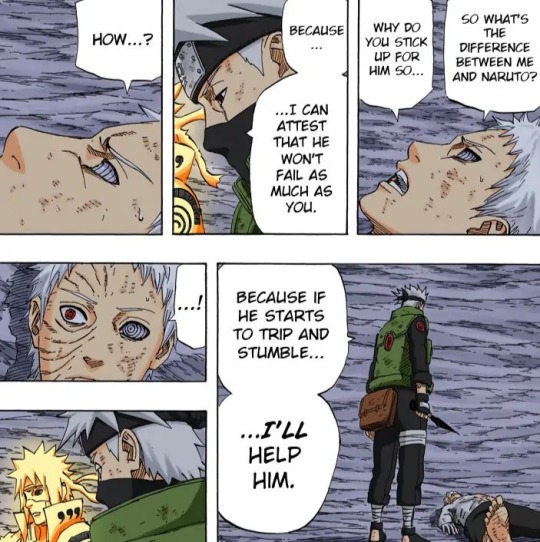
#I thought about Phil from Hercules at first#But then I remember him spying on the Nymphs while they were taking a bath and was like. Nope Jiraiya.#konohagakurekakashi#Hatake Kakashi [The Scarecrow]#Hatake Kakashi#Ask Answered#Character Analysis#Disney Princess Kakashi#Senjutsunade#Naruto#Naruto Manga
18 notes
·
View notes
Text
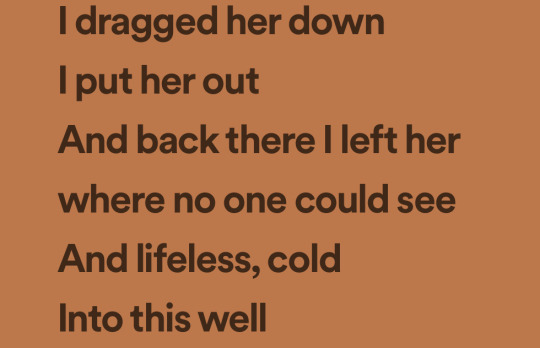
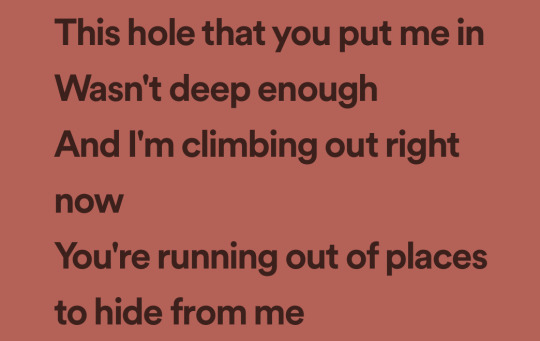

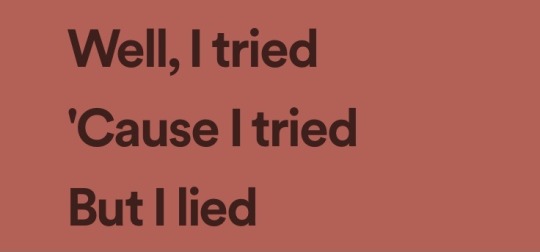






My Chemical Romance - Lyrical Parallels
#you know how ive repeatedly said gerard writes about the same 10 things over and over? yeah.#will be doing a more in depth analysis of this later#what if I DIED#one I didn’t add was ‘like scarecrows that fuel this flame we’re burning forever and ever’ from demo lovers#and ‘heat burns my skin’ from scarecrow only because that only feels more superficial#I’m so normal#my chemical romance#mcr#jude.txt
385 notes
·
View notes
Text
Many people wear metaphorical masks, a Japanese saying goes something along the lines of "a man wears three masks, one for strangers, one for loved ones, and one for himself"
Jonathan Crane wears a literal mask. Except, he feels most at home with the mask on. We see more and more in comics that he feels "naked" (his words) without it, and given the opportunity he'll ask for it from a guard or even Batman
When Jonathan puts on his burlap, he feels himself. He feels like the master of fear, not only does it give him confidence, but it gives him a scary look,so really--it's perfect for him.
I feel like Jonathan's metaphorical mask is when he's not the Scarecrow. When he's bare, human, dare I say...normal
But once the mask is donned, you better run
#Jonathan Crane#Scarecrow#Scarecrow Analysis#Mistress' Headcanons#Masks#Jonathan Crane's Mask#DC#DC Comics
80 notes
·
View notes
Text
Can someone PLEASE attack my professor of dimensions and safety models????
I can't stand that man, really. And he wants us to do, what? A fucking thesis! Man, I'm in my second year, give me a break.
Also, he gave me the most challenging city to do the project. It will take me at least 50 pages to do the analysis
#analysis gotham security AND insecurity#and explain where the errors are???#man#where do i start?#AND do a plan#a security strategy for Gotham#that SHOULD work#how i start that?#not only that#i need to justify the reason for every single thing in the strategy#and also take in count international threats#I bet it will be 100 pages minimum#dc rp#dc rp blog#dc comics#dc universe#dcu#gotham roleplay#gotham#only in gotham#gotham rp#gotham university#scarecrow#the riddler#the penguin#someone!#condiment king! please!
10 notes
·
View notes
Text
Tim and Jason have both overpowered fear toxin through sheer force of will
#dc#dc comics#comics#detective comics#batman comics#red hood comics#batfam#batfamily#batkids#comic books#tim drake#robin tim drake#robin#jason todd#red hood#the red hood#parallelism#parallels#character parallels#fear toxin#scarecrow#media analysis#media commentary#batsiblings#batbros#jason and tim#jason & tim
107 notes
·
View notes
Text






The batman adventures has one of my favourite Jonathan scenes.
Maybe im just soft but the pure ecstasy and joy when he revels in his victory saddens me. His obsession, his need to be a source of terror. Yes it’s sadistic and evil but its not fun to see someone whos completely lost themselves like Jon has. People are not born evil. He must’ve been good at one point. Innocent at least.
At least to my knowledge whilst not canon the batman adventures comics have the same lore and characters as BTAS. We only ever see a younger Jon being cruel and obsessed with fear out of interest and sadism but I doubt that’s the whole story.

He was talking to his henchmen during the scene where he monologues. I doubt he would give the full truth and would probably try to seem more scary by painting himself the way he did.
I do believe part of it was honest. But what I want to know is the part before that. What started his fixation.
I wouldn’t be shocked if he had been bullied like many of his usual interpretations and or had a rough home life. He clearly has fairly fragile self esteem given how much he overreacted to being mildly insulted whilst getting fired. Not to mention kids who do show traits of sadism do usually have things like that going on behind the scenes.
And so we return to the comic.
Theyre all finally scared of me.
Yes you could read that surface level. But the possible deeper meanings especially with his mostly unknown past just. Depress me.
When some animals are terrified. They try to make themselves look scary in response. After all.
No matter his past. Jon has become the scarecrow. He has become so fixated on fear its all that matters to him. Its consumed him completely.
But people dont fear crane like he wants. They fear his persona. Hes become so lost in the scarecrow that he and everyone else forgets that he is just a man, and when his mask. His defence is removed. He is still what he always was. Just a weak, selfish human. That nobody fears.
#jonathan crane#batman#btas jonathan crane#the batman adventures#scarecrow#BTAS#btas scarecrow#batman analysis#character analysis#he is so sad gerbil coded#I wanna hug him
77 notes
·
View notes
Note
for the scarecrow ask meme, how about a number nine?
Omg thanks for sending this ask, sweet anon! :D
Number nine is: Who are they attracted to, if anyone?
Ooooh this is kinda harder than i would have thought!!
Weirdly enough scarecrow is one comfort character i dont totally have a ship for. So i guess i kinda view him as aroace-spec. However, when i do ship him, its usually with killer croc, harley quinn, batman, or bane. So i gotta say omniromantic.
I think hes honestly attracted to someone who thinks like him, but has some sort of soft side. After all, because of all his childhood abuse, he’s not going to be keen on trusting others, let alone even believing that someone is attracted to him! I think he’d want stability and trust in his relationship, even if the other person is a chaos-inducing criminal. I think the “stability” that his partner must provide is that they will never hurt him, emotionally or physically.
I dont think appearances really matter to him— he’s more demi in that aspect. He finds people “pretty” after he already likes them.
I also think hes attracted to people who balance him out in some way— whether than be harley with her chaos or batman with his sense of justice, etc. After all, he is a psychologist at heart— he’s going to be attracted to someone that piques his interest!
Thanks for the ask, anon!! :D
I’d love to hear what u think if u want to chat :>
5 notes
·
View notes